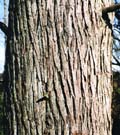
Bark of a 35 cm dbh tree at Carolina Sandhills National Wildlife Refuge, SC [C.J. Earle].
Common Names
Eastern redcedar, red or eastern juniper (1, 3), genévrier rouge (4).Taxonomic notes
Two varieties, virginiana and silicicola .Description
"Trees dioecious, to 30 m, single-stemmed; crown narrowly erect to conical, round, or flattened. Bark brown, exfoliating in thin strips, that of small branchlets (5-10 mm diam.) smooth, that of larger branchlets usually not exfoliating in plates. Branches pendulous to ascending; branchlets generally erect, sometimes lax to flaccid, 3-4-sided in cross section, ca. 2/3 or less as wide as length of scalelike leaves. Leaves green but sometimes turning reddish brown in winter, abaxial gland elliptic or elongate, conspicuous, exudate absent, margins entire (at 20× and 40×); whip leaves 3-6 mm, not glaucous adaxially; scalelike leaves 1-3 mm, overlapping by more than 1/4 their length, keeled, apex obtuse to acute, spreading. Seed cones maturing in 1 year, of 1 size, generally with straight peduncles, globose to ovoid, 3-6(-7) mm, blue-black to brownish blue when mature, glaucous, soft and resinous, with 1-2(-3) seeds. Seeds 1.5-4 mm" (4).Range
SE Canada & E US (1). The most widely distributed conifer in the eastern United States (2). See also (6).Big Tree
The largest recorded specimens for both varieties are almost identical in size, about 160 cm dbh and 22 m tall. See vars. virginiana and silicicola .Oldest
See below.Dendrochronology
Trees over 500 years old have been found in the Kansas-Oklahoma-Texas area in the course of the Ancient Cross Timbers Project (5), which has performed ecological, historical/archeological and climatic studies using this species and (primarily) the post oak, Quercus stellata .Ethnobotany
Its wood contains an oil that deters moths and is often used to line chests. The wood has also been used for making wooden pencils (2).Observations
Remarks
Citations
(1) Silba, J. 1986. An international census of the Coniferae. Phytologia memoir no. 8. Corvallis, Or.: H.N. Moldenke and A.L. Moldenke.(2) "Juniper," Encarta 97.
(3) Peattie, Donald Culross. 1950. A natural history of western trees. New York: Bonanza.
(4) Adams, Robert P. in Flora of North America online .
(5) The Ancient Cross Timbers Project, website administered by the Tree-Ring Laboratory, University of Arkansas, Fayetteville, address http://www.uark.edu/misc/xtimber/index.html , accessed 6-Jan-1999.
(6) Robert S. Thompson, Katherine H. Anderson and Patrick J. Bartlein. 1999. Atlas of Relations Between Climatic Parameters and Distributions of Important Trees and Shrubs in North America. U.S. Geological Survey Professional Paper 1650 A&B. URL= http://greenwood.cr.usgs.gov/pub/ppapers/p1650-a/pages/conifers.html , accessed 22-Jan-2000.
See also
Burns, R.M. and B.H. Honkala. 1990. Silvics of North America, Vol. 1, Conifers. Washington DC: U.S.D.A. Forest Service Agriculture Handbook 654. http://willow.ncfes.umn.edu/silvics_manual/Table_of_contents.htm .
Vascular Plant Image Gallery .
Anantha M. Prasad and Louis R. Iverson. 1999. A Climate Change Atlas for 80 Forest Tree Species of the Eastern United States. http://www.fs.fed.us/ne/delaware/atlas/ . Delaware, Ohio: USFS Northeastern Research Station.
back | Juniperus | Cupressaceae | home
This page is from the Gymnosperm Database
URL: http://www.geocities.com/~earlecj/cu/ju/virginiana.htm
Edited by Christopher J. Earle
E-mail:
earlecj@earthlink.com
Last modified on 22-Jan-2000